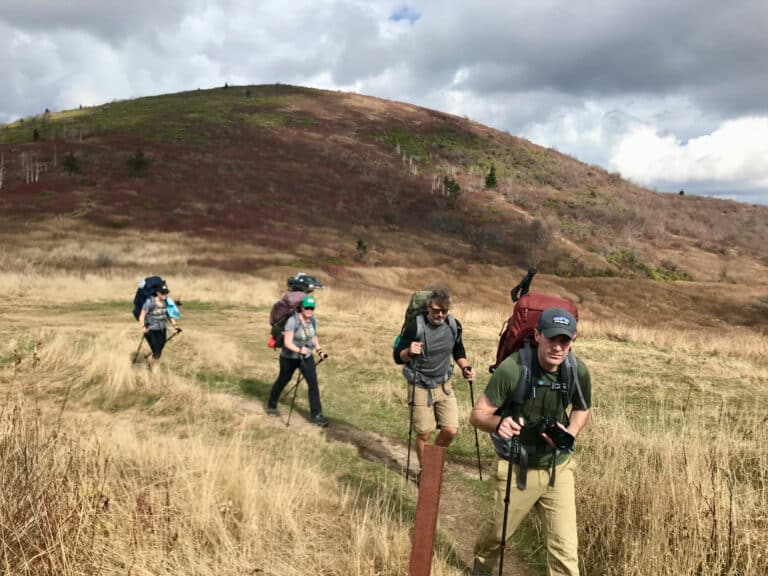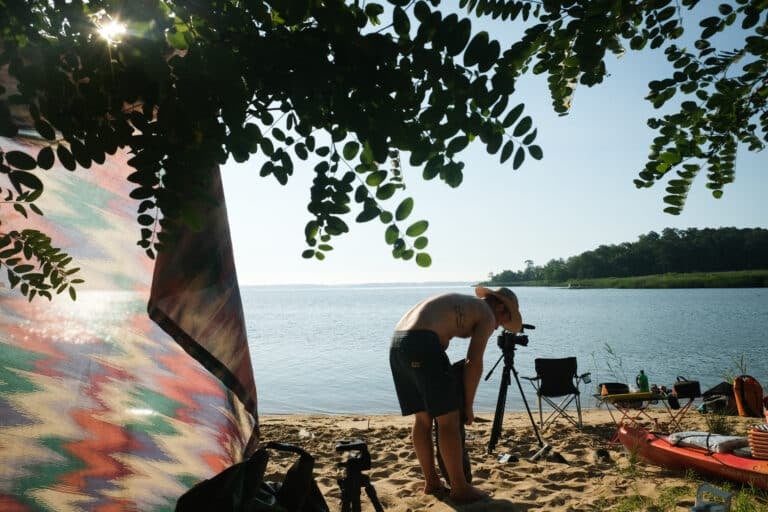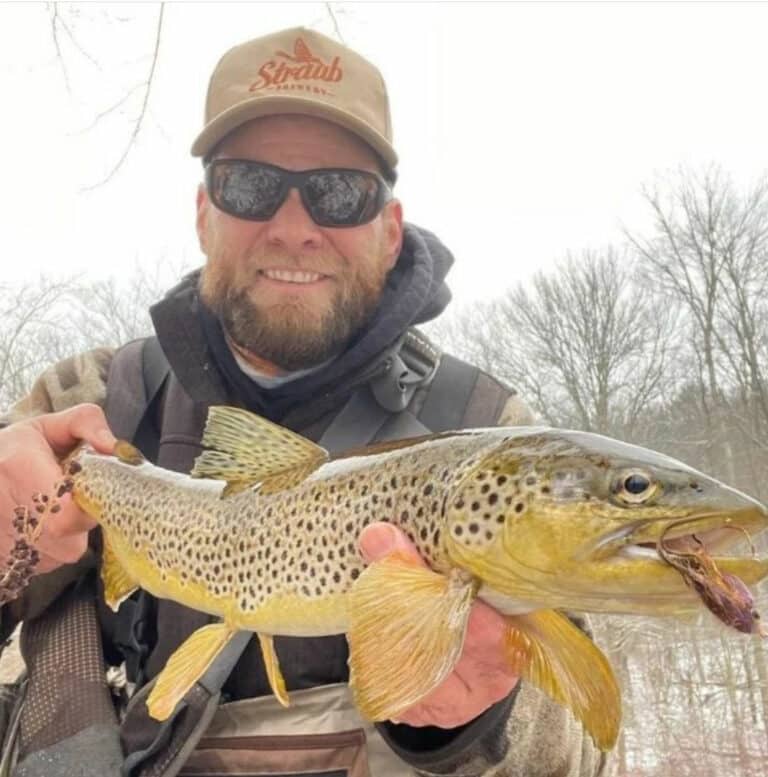by DANA WILDSMITH
It was a Saturday evening at the dim end of dusk, when there’s still light enough for a walk, but only barely. The wood thrushes had ended their daylong vows of silence and had begun chiming in the nighttime. My partner Don for once was looking up as we walked, instead of staring at the ground. “Look up!” I’m always telling him. “You’ll make yourself hunchbacked, and you miss what’s going on.” This time he had his eyes forward, and so did I, so we both missed the young timber rattler that had come out onto the road to cool himself. He was the same color as the dirt and gravel, the same size as many of the sticks littering the ground. I stepped on him in my sandals. He bit me.
“What was that?” I said. Not much of a reaction, but his bite had been quick and hadn’t hurt much: a sharp little slice, that’s all—the sort you’d feel if you nicked your finger with a kitchen knife. I thought I’d stepped on a piece of glass or metal. Then I twisted to look down behind me and saw him there with his small head raised, his spine still rigid from striking. My first thought was that the rattler seemed as surprised by what he’d done as I was. He was a young guy and probably didn’t yet realize that he’d come into this north Georgia world equipped with poison-ejecting equipment. Whoa. What the heck did I just do? That’s what he looked like he was thinking.
At this point in my story, listeners usually say, “Oh, you’re lucky he was a young one.” Actually, no. Mature pit vipers prefer to deliver a warning dose of venom, not their full load. Young ones haven’t yet learned to control the amount they inject, and thus they give their all. I got this teenager’s entire wad, direct into two neat slashes on my right instep. I sat down.
Venom travels through your circulatory system, burning blood-vessel walls like acid as it goes, so the slower you can get your blood to flow, the better. Knowing this, I did not try to walk to our car just ten yards away. Don ran to the house for the cell phone and the car keys and drove me to the fire station.
The firemen sat me down and questioned me about what the snake had looked like and how many minutes it had been since I’d been bitten. They were impressed that I knew it was a timber rattler and that I had noticed how many rattles it had (two). I could tell they had to stop themselves from saying, “Oh, cool!” when they looked at the fang marks. I wouldn’t have cared. The bite did look cool, in a Stephen King sort of way.
The ambulance got to the fire station in under five minutes. I joked with the big, friendly EMT who was icing down my leg and checking my vitals. He joked back, “I hope you don’t think I’m going to lean over and suck the venom out of your foot.” It was the best thing he could have said. Humor helps to diffuse scary situations. It gives you a sense of perspective, which is the first thing we lose in any emergency.
In the hospital emergency room I kept my full bladder to myself as long as I could, not wanting to trouble anyone. When I had to ask the nurse for some way to go, she laughed and said, “If I’d been bitten by a rattlesnake, I would already have peed. I can’t believe you weren’t scared.”
It’s true, I wasn’t scared when it happened. I was purposeful. I knew bad things were going to come of that moment, and I needed to work my hardest to minimize their number and intensity. I didn’t get scared until a doctor came to talk to me about the antivenom.
Despite my wilderness-survival training, I’d always believed that antivenom worked the way it did on TV: the snakebite victim gets wheeled into the emergency room, someone grabs a hypodermic full of serum, and another life is saved. No problem. But there is a problem, this kind doctor explained to me. The antivenom has to be given in a series of shots, as few as ten and as many as fifteen, and a high percentage of patients experience an allergic reaction with symptoms ranging from a rash to death. Also, there is only a six-hour window of effectiveness. As the doctor talked, the hospital lab techs were at work mixing the antivenom, and now I had to decide whether to allow it, and possibly die, or not allow it, and possibly die.
I told him I needed a little time. I wanted first to try to think the venom into slowing its path of destruction through biofeedback. The doctor was pleased. Next I turned down the shot of synthetic morphine a nurse brought in, despite the pain now rocketing off the one-to-ten scale posted on the wall, because I wanted to be able to listen to my body.
Here’s where I need to pause and praise my parents for teaching me that body and mind are a unit, a pair, a married couple, lovers. Anyone who has been in a long relationship can tell you that communication keeps the bond alive and — more important — growing. The most important part of communication is not the ability to talk, but the ability to listen. Mama is a genius at hearing what her body’s trying to tell her, but Daddy took it to a professional level. A United Methodist minister, he earned two master’s degrees: one in divinity, and one in psychological counseling. When counseling his parishioners, he often taught them to use visualization and biofeedback as means to conquer addictions. He used visualization himself to conquer pain, refusing novocaine from dentists, for instance. “Give me a minute,” he’d tell them, and he would then look into his own body and visualize the nerve endings being silenced. When I was in my twenties, I used the same method to banish the migraines that had been plaguing me. I have never, however, been bold enough to use biofeedback to entertain myself during long hospital stays, as Daddy was known to do: while hooked to a blood-pressure machine being monitored at the nurses’ station, he would will his blood pressure to skyrocket, then will it back to normal as soon as he heard a nurse running for his room.
It is this idea of listening to what your body wants to tell you, rather than rushing to shut up any sounds from inside, that most often puts me at odds with the medical profession. But that wise emergency-room doctor was willing to give me time to listen to what my body had to say, and later, after I was admitted, a night nurse and I talked about her fight with her gynecologist. “He wants to give me hormones for perimenopause,” she said. “I keep telling him that menopause and hot flashes are all part of a natural process. It’s what my body is supposed to be doing right now. It’s normal.” So, too, is pain after a poisonous snake bites you. The first stage of a snakebite is a process of destruction, and I needed to hear what the extent of the damage was. Later, after the destruction had been halted as much as possible and the recovery process had begun, pain would become less informative, and only then would I be able to afford the luxury of painkillers.
Along about one o’clock in the morning, toward the end of my six-hour window in which to take the antivenom, something changed, and I could tell the poison was no longer progressing up my leg. The hard jerking in the muscles had eased off a bit, and the red pain had faded to a paler color. I knew, just as surely as if some digital readout had indicated it, that I would not get any worse. I told the doctor we’d not be using the antivenom, thanks just the same. He was relieved. I was too.
Then the hard part started. My veins were still full of poison that was eating away at my blood vessels, causing them to hemorrhage and leak, allowing the poison to infiltrate my tissues. Over the course of the next week, my foot turned black, and my leg turned intense shades of purple, orange, and yellow. Swelling began around the bite area and spread until I had no visible arch in my foot, then no visible ankle, and finally no visible knee. My right leg grew to twice the size of my left. Standing up became an exercise in agony as blood invaded my poor, abused vessels, which screamed in protest. I tell you this to engender not pity but understanding. Time and again since I was bitten, people are surprised to learn that I was still in pain two weeks after it happened. They don’t realize that poison destroys the parts of the body it invades, and though the damage is fixable, the fix is a long time coming.
Such denial of long-term consequences is all too common in our culture. As an activist for the environmental health of northern Georgia, I talk with many people—smart people, good people—who can see no connection between the water they use in their kitchens and the water that flows in my creek. It’s almost as if they view nature as a third-world country: they know it exists, but they wouldn’t go there, because it’s not safe or clean. I’ve had many people ask if I’m going to stop walking in the woods now, the same way they might assume that if I’d been robbed in Somalia, I would never go back. And because they don’t know woods in the familiar way they know their computer or their car, they have a hard time connecting the health of our environment with the way they live their lives. This whole episode with the snakebite has turned me into a human example of what one quick dumping of poison can do to arteries — my own arteries, or those of our Southern waterways.
I have also had people ask if I now wear boots when I take my every-other-morning walk. And do I carry a gun? “Do you wear boots when you go for a walk?” I ask them. “Do you carry a gun when you weed your tomatoes?” When I told a woman I know that I’d I spent all Saturday working in my garden, she asked me, “Did you wear waders?” I told her no, I wore sandals, same as always, to which she replied, “Some people never learn.”
I don’t want to believe people are intentionally unkind, so I’ve tried to figure out what makes so many of them determined to blame me for being bitten. I’ve come to the conclusion that they brand me as stupid or irresponsible to reassure themselves that what happened to me will never happen to them. She’s an old hippie who does oddball things, and I’m not, their subconscious murmurs. Therefore no snake will ever bite me.
And maybe they have a point. I do live my life in a more daring way than many Americans choose to. And the more I expand my horizons, the more I allow for potential mishaps. But I don’t consider this a foolhardy way to live—I consider this the only way to live. I will not armor myself against nature. If I shut out parts of the natural world that might hurt me, I would become as vacuum-sealed as all those houses whose blinds are never raised, whose windows are never opened, whose central heat and air is never turned off. I want to be as ever-changing as the wilderness, with its attendant risks, and if I die, I die.
Which brings me to the other side of the coin: those dear souls who point out the positive when they talk about the snakebite. My family doctor told me he was grateful for my stunning good health because it pulled me through what would have killed or maimed many others. A retired-dentist friend stopped me months after the incident to say, “You know, it’s only because you knew exactly what to do after you were bitten that you survived.”
Even such moments of praise, though, come tinged with a shade of wonder. Life’s dark side took a nip out of me, and I survived. Why?
It’s a question I’ve faced a number of times in my life. First there was the pneumonia that almost took me at six months. Then, at age ten, while Emory doctors were examining my heart to see exactly what the problem with it was, I lay on the catheterization table and watched the heart monitor flat-line. I remember knowing it was significant but not feeling concerned about it.
Four years later, on a cold February night in Savannah, I stood reading in front of the parsonage fireplace, my open book resting on the mantle. A volley of sparks suddenly sprayed from the logs and burrowed into the flannel of my floor-length nightgown. The flame grew like a live thing and crawled up my left side, reaching for my hands and face. I fell to the carpet and rolled in the manner every schoolchild is taught, but when I stood up, the flame roared back to life, wrapped me in its wings, and began to dissolve me.
This is what burning is like: not a cooking, but a wet scrubbing-off of clothes and flesh. I was screaming, but I heard nothing. I moved through the dining room in awkward slow motion, flames draping me like a birth caul. Mama ran from the bath she’d been taking and swaddled me with wet towels.
Somehow I knew I would not die. Dying was not even the worst possibility—survival was. I sat on the old wood floor in front of the bathroom door, waiting for the ambulance, staring down at my roasted hands. I kept saying to Mama, “I’ve ruined my hands. I’ve ruined my hands.” I was 14 years old.
Why did I survive? Countless people have suggested I did not die because God had a plan for me. But if God kept me alive in order that I might live out his plan, wouldn’t this imply that it was also God who brought me so near to death? Did God set a young girl on fire just so he could snatch her back from the brink at the last moment, slightly charred around the edges? Talk about dark comedy. Personally, I don’t hold much truck with a God who niggles away his days making things happen or not happen. That sounds to me like a small-minded, control-freak God. That sounds to me an awful lot like taking someone’s idea of human nature and calling it “God.”
I think it matters not one hoot why a particular calamity happens to me, or to you, or to any of us. What matters is how we deal with it. Musings about fate could not put skin back on my body. Healing from being burned is hard work. I didn’t have the energy for anything else.
When that rattlesnake bit me last summer, I did not sit on the side of the road moaning, “Oh, why would God let this happen to me?” Nor was my first thought to kill the snake. That was not even my second or third or fortieth thought. I did not kill that snake, and I did not hunt down and exterminate his cousins in a blood feud. A man who knew about my snakebite told me he had set out to destroy the entire snake population on his several wooded acres. He seemed to think I might see this as a worthy endeavor. But where does such an approach stop? Should we also kill all spiders, in order that not one brown recluse should live? Should we cut down all trees in anticipation that one rogue limb might break off and bean someone in the head?
Halfway up our big hill is an old oak that grows straight, as it should, for seven feet or so, then takes a sharp ninety-degree turn, growing parallel to the ground for a few feet, then heads for the heavens again. I call this our “signal oak,” after a legend I’ve heard of how local Native Americans once trained trees to grow pointing in a desired direction, like living signposts. My tree wasn’t yet an acorn when the last Cherokee left these low hills, so its sharp bend must be due to accident or climate. It could be that an older tree fell across its young trunk, warping it. The fallen tree eventually rotted away, allowing my signal oak to right itself.
I feel a kinship with this tree because I’ve felt death fling its weight across me now and again, and the best response I could think of was to bend a bit and hold steady until the load fell off. Is there a reason I have survived? Who knows? All that matters is that, like the signal oak, I adjusted my stance until I was able to straighten up again. Walking my woods, I see every tree, every sprig of jewelweed, every salamander, and, yes, every snake trying to hold on in a paved world, and I know exactly what hard work survival is. •







